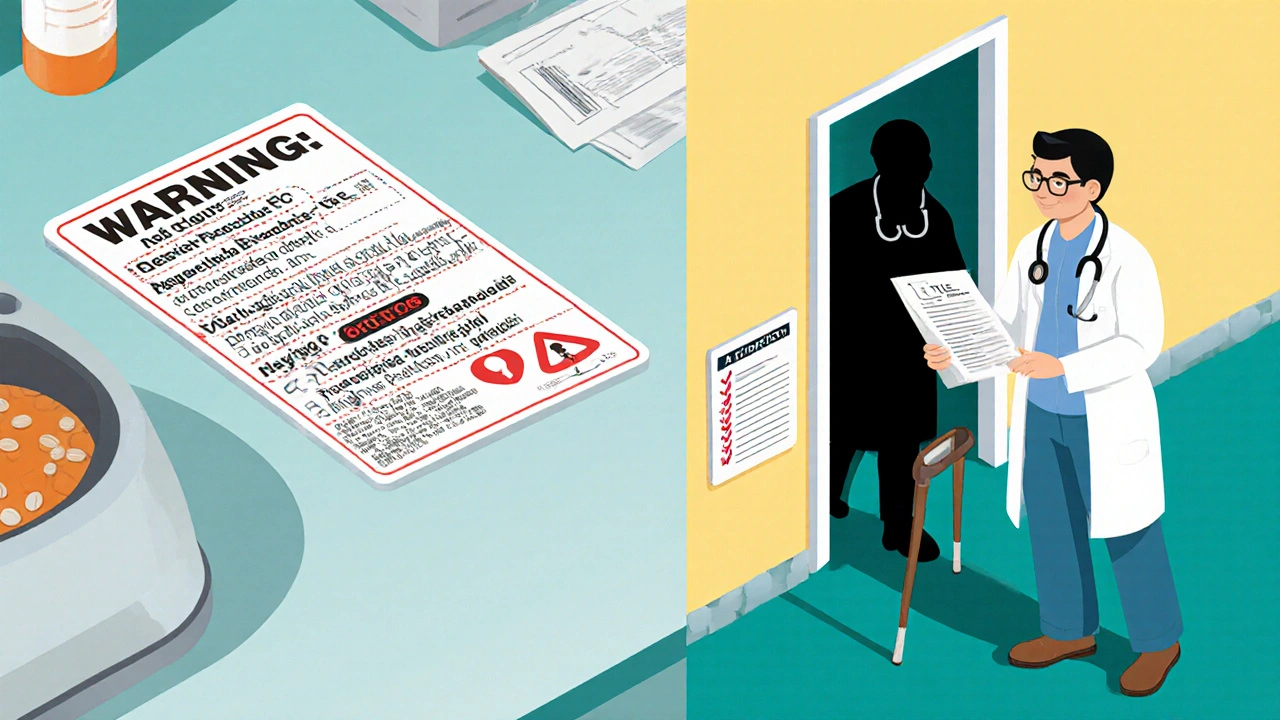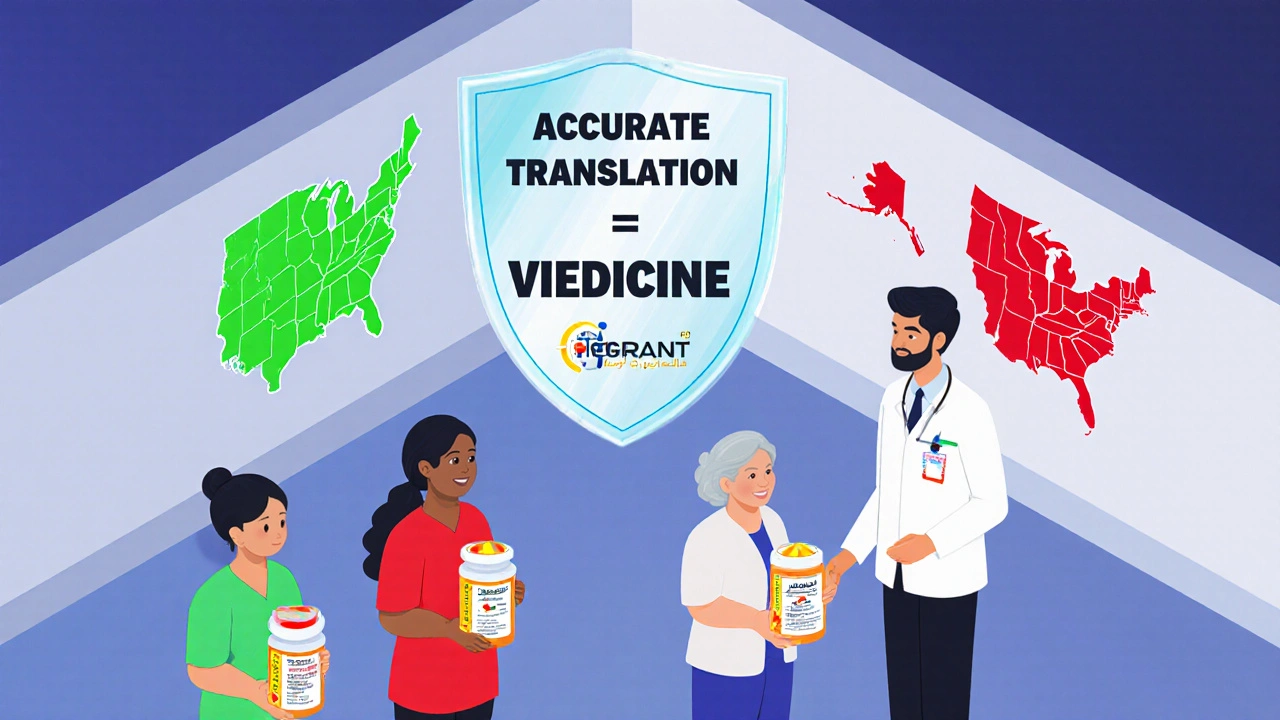Getting the wrong dose of medicine because of a bad translation isn’t just a mistake-it can land you in the hospital. For millions of Americans who don’t speak English well, prescription labels are often written in a language they can’t understand, or worse, in a version that’s been auto-translated and turned into nonsense. A single word flipped by a computer can mean the difference between healing and harm.
How Computer Translations Put Lives at Risk
Most pharmacies rely on cheap, automated translation tools to turn English labels into Spanish, Chinese, Vietnamese, or Arabic. These systems don’t understand medical terms. They just swap words. That’s why prescription label translation errors are so common-and so dangerous.Take the word "once." In English, it means "one time." In Spanish, "once" means "eleven." So if your label says "tome once al día," you’re being told to take eleven pills a day, not one. That’s not a typo. That’s a system failure. A 2010 study in the Bronx found that half of all Spanish-language prescription labels had mistakes like this. Some patients took 11 times their prescribed dose because of a single word.
It’s not just Spanish. The same problem happens in other languages. "Take two tablets twice daily" might become "take two tablets twice weekly" in a bad translation. A dose meant for morning could end up labeled for bedtime. Medication purpose? "For high blood pressure" might turn into "for headaches." These aren’t rare accidents. They’re the norm in pharmacies that skip professional translation.
Why Some Pharmacies Get It Right
Not all pharmacies cut corners. Those that use certified medical translators-people trained in both language and medicine-get it right 98% of the time. These translators don’t just know words. They know what "take on an empty stomach" really means. They understand that "alcohol" in Latin America means rubbing alcohol, but in Spain it means drinking alcohol. They catch false cognates before they reach the patient.California and New York are the only two states that legally require pharmacies to provide accurate translated labels. Since California passed its law in 2016, medication errors among Spanish-speaking patients dropped by 32%. ER visits for drug-related problems fell by 27%. The cost? About 25 cents more per prescription. The savings? Thousands of avoided hospital stays.
Big pharmacy chains like Walgreens and CVS have started rolling out AI-assisted systems that combine machine translation with pharmacist review. Walgreens’ MedTranslate system cut errors by 63% in pilot stores. CVS’s LanguageBridge uses neural translation but still requires a human to verify every high-risk drug. These aren’t perfect-but they’re a huge step forward.
What Happens When You Can’t Read Your Label
If you’re a non-English speaker, you’ve probably faced this: You get your pills. You can’t read the instructions. You don’t want to look foolish, so you guess. Maybe you take it when you eat. Maybe you skip a day because you thought it was "twice a week." Maybe you didn’t realize your medicine was for your heart, not your stomach.A 2023 survey found that 63% of patients with limited English proficiency were confused by their prescription labels. Nearly 3 in 10 admitted they took the wrong dose because of the translation. One Reddit user shared how their mother’s blood thinner label changed from "once daily" to "eleven times daily" at one pharmacy chain-but was correct at another. She didn’t notice until she got dizzy and collapsed.
These aren’t hypotheticals. They’re real stories from people who trusted their pharmacy to keep them safe.

How to Get Help-Even If Your Pharmacy Doesn’t Offer Translation
You don’t have to accept bad translations. Here’s what you can do:- Ask for a human translator. Call ahead and ask if the pharmacy has a certified medical interpreter on staff. If they say no, ask if they can arrange one over the phone or video call. Many pharmacies can connect you to services like LanguageLine or CyraCom.
- Request a printed bilingual label. Under Title VI of the Civil Rights Act, pharmacies receiving federal funding must provide language assistance. You have the right to a clear, accurate label in your language. Don’t settle for a printout from a machine.
- Bring someone who speaks both languages. Take a trusted friend, family member, or community health worker to your pharmacy. Have them read the label with you and compare it to what your doctor told you.
- Use free translation services. Many community health centers, nonprofits, and local libraries offer free medical interpretation. The National Health Law Program has a directory of free resources for LEP patients.
- Report bad translations. If you get a dangerous label, report it. File a complaint with your state’s pharmacy board or the U.S. Department of Health and Human Services. Your report can help change policy.
The Bigger Picture: Why This Isn’t Just a Pharmacy Problem
This isn’t just about labels. It’s about equity. Over 25 million Americans have limited English proficiency. Spanish speakers make up 15.8 million of them. Chinese, Vietnamese, Arabic, and other languages are growing fast. But most pharmacies still treat translation as an afterthought.The federal government is starting to act. In March 2024, HHS launched a $25 million grant program to help pharmacies buy better translation tools. The FDA now recommends that all prescription labels use plain language-simple words, clear instructions-to make translation easier. And 17 states are considering laws like California’s.
But change moves slowly. Until then, you need to protect yourself. Don’t assume your label is accurate. Don’t be afraid to ask. Don’t take a pill if you’re unsure what it’s for.

What’s Being Done-and What’s Still Missing
The technology exists. The standards exist. The law says you have a right to clear information. But implementation? That’s where it falls apart.Only 23% of pharmacies offer translation for languages like Chinese or Vietnamese. Most don’t train staff on language access laws. Many still use third-party systems that don’t even check for consistency-so the same drug might have three different translations across different stores.
What’s needed? Mandatory national standards. Certification for medical translators working in pharmacies. Regular audits of translation quality. And accountability when mistakes happen.
Right now, the burden is on the patient. That’s wrong. Medication safety shouldn’t depend on whether you speak English well.
Final Advice: Your Safety Comes First
If you or a loved one relies on translated prescription labels, here’s your checklist:- Always ask for a human translator, not a machine.
- Compare the label to what your doctor told you.
- Write down your questions before you go to the pharmacy.
- If something sounds wrong, trust your gut. Ask again.
- Keep a list of all your medications and instructions in your language.
- Know your rights. You are not asking for a favor-you’re asking for safe care.
Medicine should heal. It shouldn’t confuse. A translated label isn’t a luxury. It’s a lifeline.


Bailey Sheppard
November 18, 2025 AT 23:30Had a friend’s dad almost end up in the ER over this. Pharmacy gave him a Spanish label that said 'tome dos veces al día' for a drug that was supposed to be once. He took it twice, thought he was being careful. Turned his blood pressure into a rollercoaster. Never again assuming a translated label is right.
Girish Pai
November 19, 2025 AT 14:36This is why India’s healthcare system is superior-no one relies on automated translation. We train pharmacists to speak 18 regional languages. If you can’t read English, you get a trained Hindi or Tamil-speaking pharmacist. No AI, no guesswork. America’s broken because it outsources responsibility instead of investing in people.
Kristi Joy
November 19, 2025 AT 17:21I work with seniors at a community center and this hits hard. One woman didn’t know her diabetes med was meant for morning-she took it at night for months because the label said 'take when you wake up' but the translation said 'take when you sleep.' She didn’t want to admit she didn’t understand. Please, if you know someone struggling, just sit with them at the pharmacy. Ask the pharmacist to explain. It takes five minutes. That’s all it takes to save a life.
Hal Nicholas
November 20, 2025 AT 15:39Of course this happens. The whole system is designed to fail people who don’t speak English. Pharmacies don’t care. They’re profit machines. The only reason California fixed it is because lawsuits piled up. Until someone sues every chain into oblivion, nothing changes. And don’t tell me about 'AI-assisted'-it’s still just a glorified Google Translate with a lab coat.
Louie Amour
November 21, 2025 AT 07:54Let’s be real-this isn’t about translation. It’s about laziness. People who can’t speak English shouldn’t be living here if they’re too lazy to learn. I’ve lived in 12 countries. I learned the language. I read every label. If you can’t handle basic English medical terms, maybe you shouldn’t be on prescription meds at all. This isn’t a civil rights issue-it’s a personal responsibility issue.
Kristina Williams
November 23, 2025 AT 04:59Did you know the government is using these bad translations to track immigrants? The FDA’s new 'plain language' push? It’s a cover. They’re putting microchips in the QR codes on labels. That’s why they’re pushing so hard for digital versions. Your blood pressure meds are also a GPS tracker. Don’t scan anything. Don’t trust any app. They’re watching.
Shilpi Tiwari
November 23, 2025 AT 12:50As a clinical pharmacist in Mumbai, I’ve seen this exact issue in multilingual India. The difference? We use tiered translation: machine-generated draft → pharmacist review → bilingual nurse verification → patient verbal confirmation. No single step is automated. The cost is negligible compared to adverse events. Why isn’t this model adopted in the U.S.? Institutional inertia. And yes, it’s a colonial hangover-English as default, everything else as 'accommodation.'
Christine Eslinger
November 24, 2025 AT 10:48One sentence: Never trust a machine with your life.
But seriously-this isn’t just about language. It’s about dignity. People don’t ask for translations because they’re lazy. They ask because they’re scared. Scared of being judged. Scared of looking stupid. Scared their child will be taken away if they admit they don’t understand. The real solution isn’t better tech. It’s creating spaces where people feel safe to say, 'I don’t understand.' That’s the first step to healing. And if your pharmacy won’t give you that? Walk out. Find one that will. Your life is worth more than their convenience.